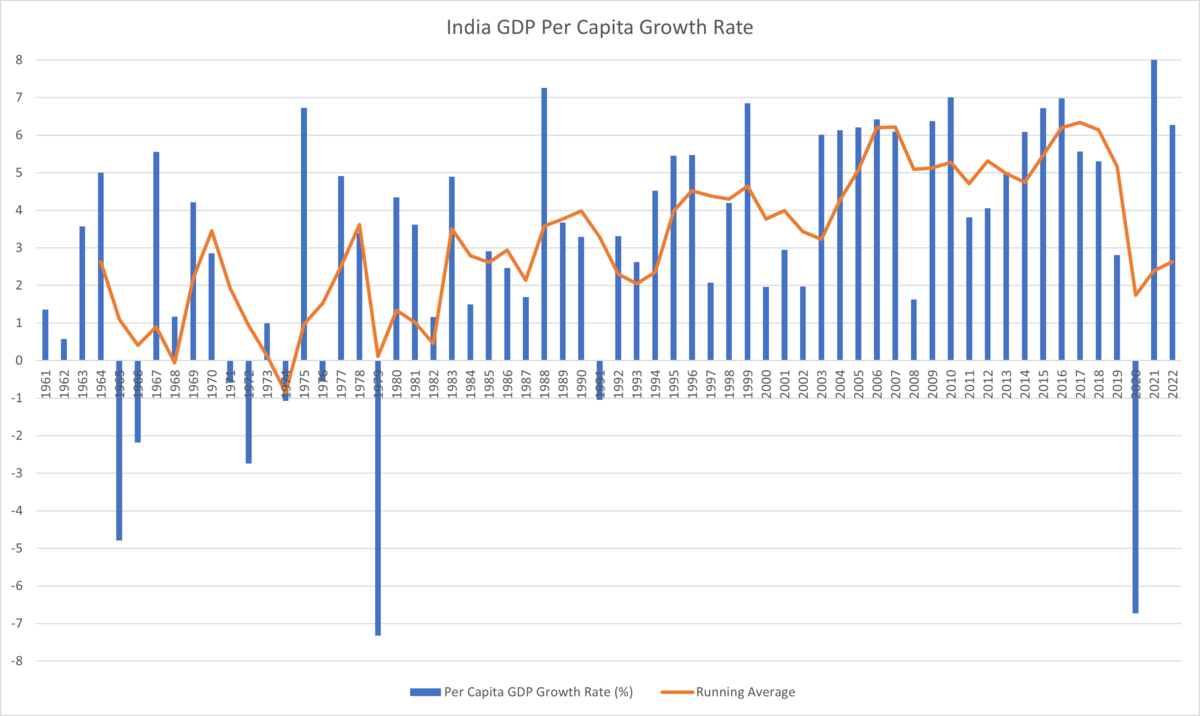Pakistan, India as well as Myanmar and Bangladesh are the four successor states to the colony often called British Raj. Pakistan and India gained independance from Britain in August 1947. Between both India most of the British colonial infrastructure including the gift of a newly built capital called New Delhi that the British bequeathd to the newly formed republic of India.
In addition British hold over what became republic of India had been longer and dated way back to 1780s. On the other hand British conquest and consolidation of the regioin coterminous to the Islamic Republic of Pakistan was shorter at just 98 years and had began in 1849.
The effect of longer British rule was that modern education and everything that comes with what was then the most advanced nation in the world - Great Britain including even cultural influence down to the English language had been ingested far deeper into what became Republic of India. Most of the New Delhi government buildings including the parliamant building were built by British in 1920-30s.
A noted British architect https://en.wikipedia.org/wiki/Sir_Edwin_Lutyens working for the British Raj was behind designing the new capital which was moved from Kolkatta in 1920s. By the time the British left most of the central New Delhi had been completed. The British Viceroys residence became the Indian President's house.

 en.wikipedia.org
en.wikipedia.org

In addition majority of British era universities, most of the western educated, English speaking social capital, most of the industry, most of the ports all went to the Republic of India. It was for this reason that the saying goes "Jinnah got a moth eaten Pakistan".
In the moth eaten Pakistan there was no capital. The new republic literally had some offices in tents while new buildings were sought oe confiscated. There was chaos and shortage of even typewriters. Being frontier region of the British Raj literacy was very low. It did not help that the British Raj reserve money ended up in the hands of India as it got the capital New Delhi. India deliberated and dragged over giving Pakistan it's due share and only with intervention of Gandhi was some money transferred.
The only positive was that the country did inherit a rather large military from the British Raj whose regiments today make the Pakistan Army. This was thanks to the fact that a abnormal numbers of soldiers were recruited from the region of coterminous Pakistan by the British.
The first decade was a struggle just to survive. Just over a decade later in 1959 did Pakistan began the construction of a new capital which India had been bequethed by the British 30 plus years before. The Indian government recieved keys from the British to a shiny capital New Delhi. Pakistan had to build a new capital Islamabad.
To understand the economics of both countries it is important to be informed by what went into making the present. Pakistan thus started from a terribly difficult and a low industrial or human capital base most of which went to India.
However a study of the per capita of both countries tells us that Pakistan was ahead of India in 1960. This tells us that a average Pakistan was better off then his counterpart in India. This lead by Pakistan continued for the next 48 years. Only in 2008 did India begin to over take Pakistan and has since then taken the lead. Thus over the last 60 years Pakistan has been ahead in this economic relay race and India has only been ahead for the recent 12 years.
Below is a chart from World Bank figures that shows GDP per capita with two slices of the last 60 years. One slice of 48 years where Pakistan and led and the recent slice of 12 years where India leads.


It is relevant to note that since 2001 Pakistan has been victim of the War on Terror. The US invasion of Afghanistan in 2001 triggered seismic tremor waves which had deleterious effects on the economy of Pakistan. The war spilled over into Pakistan's border regions and by 2010 think tanks in West were publishing reports of the imminent collapse of the Pakistani state and what should be done, prepare contingency plans in how to secure the countries nuclear warheads. Obviously this had massive impact on the economy and long term planning as the governments became overwhelmed by issues related to the War on Terror. In addition globally the countries imnage took a battering which impacted exports. Buyers were hesitant to come to Pakistan and costs like insurance went out of the roof.
The country in 2021 is just about coming out of this two decades of chaos. This must be kept in mind when looking at the economic performance of recent period. I know the fact that India is ahead today is source of much pride to Indians and shows up as bluster. But it is not end of history. This is a relay race that continues.
For decades as can be seen in the World Bank sourced chart India lagged and became famous for it's "Hindu Growth Rate" which was another way of saying "snail pace". So I want to end with this take away. Never consign one participant in this relay race. You never know what the future will bring. Using the present to declare victory is infantile.
The Hindu rate of growth is a term referring to the low annual growth rate of the economy of India before the economic reforms of 1991, which stagnated around 3.5% from 1950s to 1980s, while per capita income growth averaged around 1.3%.[1

 en.wikipedia.org
en.wikipedia.org
@Nilgiri @Yankeestani @Saiyan0321 @Waz @Jackdaws
In addition British hold over what became republic of India had been longer and dated way back to 1780s. On the other hand British conquest and consolidation of the regioin coterminous to the Islamic Republic of Pakistan was shorter at just 98 years and had began in 1849.
The effect of longer British rule was that modern education and everything that comes with what was then the most advanced nation in the world - Great Britain including even cultural influence down to the English language had been ingested far deeper into what became Republic of India. Most of the New Delhi government buildings including the parliamant building were built by British in 1920-30s.
A noted British architect https://en.wikipedia.org/wiki/Sir_Edwin_Lutyens working for the British Raj was behind designing the new capital which was moved from Kolkatta in 1920s. By the time the British left most of the central New Delhi had been completed. The British Viceroys residence became the Indian President's house.

Lutyens' Delhi - Wikipedia
In addition majority of British era universities, most of the western educated, English speaking social capital, most of the industry, most of the ports all went to the Republic of India. It was for this reason that the saying goes "Jinnah got a moth eaten Pakistan".
In the moth eaten Pakistan there was no capital. The new republic literally had some offices in tents while new buildings were sought oe confiscated. There was chaos and shortage of even typewriters. Being frontier region of the British Raj literacy was very low. It did not help that the British Raj reserve money ended up in the hands of India as it got the capital New Delhi. India deliberated and dragged over giving Pakistan it's due share and only with intervention of Gandhi was some money transferred.
The only positive was that the country did inherit a rather large military from the British Raj whose regiments today make the Pakistan Army. This was thanks to the fact that a abnormal numbers of soldiers were recruited from the region of coterminous Pakistan by the British.
The first decade was a struggle just to survive. Just over a decade later in 1959 did Pakistan began the construction of a new capital which India had been bequethed by the British 30 plus years before. The Indian government recieved keys from the British to a shiny capital New Delhi. Pakistan had to build a new capital Islamabad.
To understand the economics of both countries it is important to be informed by what went into making the present. Pakistan thus started from a terribly difficult and a low industrial or human capital base most of which went to India.
However a study of the per capita of both countries tells us that Pakistan was ahead of India in 1960. This tells us that a average Pakistan was better off then his counterpart in India. This lead by Pakistan continued for the next 48 years. Only in 2008 did India begin to over take Pakistan and has since then taken the lead. Thus over the last 60 years Pakistan has been ahead in this economic relay race and India has only been ahead for the recent 12 years.
Below is a chart from World Bank figures that shows GDP per capita with two slices of the last 60 years. One slice of 48 years where Pakistan and led and the recent slice of 12 years where India leads.
It is relevant to note that since 2001 Pakistan has been victim of the War on Terror. The US invasion of Afghanistan in 2001 triggered seismic tremor waves which had deleterious effects on the economy of Pakistan. The war spilled over into Pakistan's border regions and by 2010 think tanks in West were publishing reports of the imminent collapse of the Pakistani state and what should be done, prepare contingency plans in how to secure the countries nuclear warheads. Obviously this had massive impact on the economy and long term planning as the governments became overwhelmed by issues related to the War on Terror. In addition globally the countries imnage took a battering which impacted exports. Buyers were hesitant to come to Pakistan and costs like insurance went out of the roof.
The country in 2021 is just about coming out of this two decades of chaos. This must be kept in mind when looking at the economic performance of recent period. I know the fact that India is ahead today is source of much pride to Indians and shows up as bluster. But it is not end of history. This is a relay race that continues.
For decades as can be seen in the World Bank sourced chart India lagged and became famous for it's "Hindu Growth Rate" which was another way of saying "snail pace". So I want to end with this take away. Never consign one participant in this relay race. You never know what the future will bring. Using the present to declare victory is infantile.
The Hindu rate of growth is a term referring to the low annual growth rate of the economy of India before the economic reforms of 1991, which stagnated around 3.5% from 1950s to 1980s, while per capita income growth averaged around 1.3%.[1

Hindu rate of growth - Wikipedia
@Nilgiri @Yankeestani @Saiyan0321 @Waz @Jackdaws








